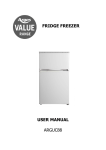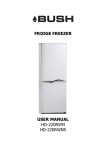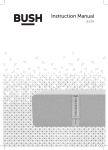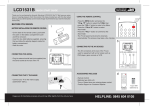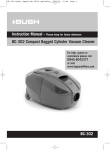Download Argos CDT16120 Instruction manual
Transcript
12V Cordless Drill Driver instruction manual CDT16120 SAFETY INSTRUCTIONS WARNING! Read all safety warnings and all instructions. Failure to follow the warnings and instructions may result in electric shock, fire and/or serious injury. Save all warnings and instructions for future reference. The term “power tool” in the warnings refers to your mains-operated (corded) power tool or battery-operated (cordless) power tool. 1) Work area safety a) Keep work area clean and well lit. Cluttered or dark areas invite accidents. b) Do not operate power tools in explosive atmospheres, such as in the presence of flammable liquids, gases or dust. Power tools create sparks which may ignite the dust or fumes. c) Keep children and bystanders away while operating a power tool. Distractions can cause you to lose control. 2) Electrical safety a) Power tool plugs must match the outlet. Never modify the plug in any way. Do not use any adapter plugs with earthed (grounded) power tools. Unmodified plugs and matching outlets will reduce risk of electric shock. b) Avoid body contact with earthed or grounded surfaces, such as pipes, radiators, ranges and refrigerators. There is an increased risk of electric shock if your body is earthed or grounded. c) Do not expose power tools to rain or wet conditions. Water entering a power tool will increase the risk of electric shock. d) Do not abuse the cord. Never use the cord for carrying, pulling or unplugging the power tool. Keep cord away from heat, oil, sharp edges or moving parts. Damaged or entangled cords increase the risk of electric shock. 2 e) When operating a power tool outdoors, use an extension cord suitable for outdoor use. Use of a cord suitable for outdoor use reduces the risk of electric shock. f) If operating a power tool in a damp location is unavoidable, use a residual current device (RCD) protected supply. Use of an RCD reduces the risk of electric shock. 3) Personal safety a) Stay alert, watch what you are doing and use common sense when operating a power tool. Do not use a power tool while you are tired or under the influence of drugs, alcohol or medication. A moment of inattention while operating power tools may result in serious personal injury. b) Use personal protective equipment. Always wear eye protection. Protective equipment such as dust mask, nonskid safety shoes, hard hat, or hearing protection used for appropriate conditions will reduce personal injuries. c) Prevent unintentional starting. Ensure the switch is in the off-position before connecting to power source and/or battery pack, picking up or carrying the tool. Carrying power tools with your finger on the switch or energising power tools that have the switch on invites accidents. d) Remove any adjusting key or wrench before turning the power tool on. A wrench or a key left attached to a rotating part of the power tool may result in personal injury. e) Do not overreach. Keep proper footing and balance at all times. This enables better control of the power tool in unexpected situations. f) Dress properly. Do not wear loose clothing or jewellery. Keep your hair, clothing and gloves away from moving parts. Loose clothes, jewellery or long hair can be caught in moving parts. g) If devices are provided for the HELPLINE NO 08707252949 connection of dust extraction and collection facilities, ensure these are connected and properly used. Use of dust collection can reduce dust-related hazards. 4) Power tool use and care a) Do not force the power tool. Use the correct power tool for your application. The correct power tool will do the job better and safer at the rate for which it was designed. b) Do not use the power tool if the switch does not turn it on and off. Any power tool that cannot be controlled with the switch is dangerous and must be repaired. c) Disconnect the plug from the power source and/or the battery pack from the power tool before making any adjustments, changing accessories, or storing power tools. Such preventive safety measures reduce the risk of starting the power tool accidentally. d) Store idle power tools out of the reach of children and do not allow persons unfamiliar with the power tool or these instructions to operate the power tool. Power tools are dangerous in the hands of untrained users. e) Maintain power tools. Check for misalignment or binding of moving parts, breakage of parts and any other condition that may affect the power tool’s operation. If damaged, have the power tool repaired before use. Many accidents are caused by poorly maintained power tools. f) Keep cutting tools sharp and clean. Properly maintained cutting tools with sharp cutting edges are less likely to bind and are easier to control. g) Use the power tool, accessories and tool bits etc. in accordance with these instructions, taking into account the working conditions and the work to be performed. Use of the power tool for operations different from those intended could result in a hazardous situation. 5) Battery tool use and care a) Recharge only with the charger specified by the manufacturer. A charger that is suitable for one type of battery pack may create a risk of fire when used with another battery pack. b) Use power tools only with specifically designated battery packs. Use of any other battery packs may create a risk of injury and fire. c) When battery pack is not in use, keep it away from other metal objects, like paper clips, coins, keys, nails, screws or other small metal objects, that can make a connection from one terminal to another. Shorting the battery terminals together may cause burns or a fire. d) Under abusive conditions, liquid may be ejected from the battery; avoid contact. If contact accidentally occurs, flush with water. If liquid contacts eyes, additionally seek medical help. Liquid ejected from the battery may cause irritation or burns. 6) Service a) Have your power tool serviced by a qualified repair person using only identical replacement parts. This will ensure that the safety of the power tool is maintained. ADDITIONAL SAFETY POINTS FOR YOUR CORDLESS DRILL 1. Remove the battery pack from the drill before carrying out adjustments. 2. Do not expose to rain or water. 3. Do not store the battery pack in temperatures over 40ºC. 4. Always charge the battery pack between temperatures 0ºC to 30ºC. Ideal charging temperature is 18 oC to 24ºC. 5. Only use the charger and the battery pack provided no others. 6. Avoid short circuit of the battery pack connections (screws & nails). 7. Do not incinerate or burn the battery HELPLINE NO 08707252949 3 pack, it may explode. 8. Do not charge a damaged battery pack. 9. Replace any damaged supply cords on your charger. 10. Always disconnect the charger power supply before making or breaking the connections to the battery pack. 11. Battery pack and charger will be warm during charging this is normal. 12. When not in use, remove a charged battery pack from the charger. 13. Always remove the battery pack from the charger immediately after re-charging is completed. 14. Your drill and battery pack will be warm when working, this is normal. 15. Do not dispose of batteries in fire, or with household waste. Return exhausted batteries to your local collection or recycling point. 16. Always check walls, floors and ceilings for hidden power cables and pipes. 17. Wear ear protection with cordless drill. Exposure to noise can cause hearing loss. 18. Accessories and metal parts can become very hot. 19. Hold tool by insulated gripping surfaces when performing an operation where the cutting tool may contact hidden wiring. Contact with a ‘live’ wire will also make exposed metal parts of the tool ‘live’ and shock the operator. expose to rain or water. 3. Do not charge non-rechargeable batteries. 4. If the supply cord is damaged, it must be replaced by the manufacturer, its service agent or similarly qualified persons in order to avoid a hazard. SYMBOLS To reduce the risk of injury, user must read instruction manual Warning Wear eye protection Wear ear protection Wear dust mask Indoor use only Do not expose to rain or water Do not burn WARNING: If a small amount of electrolyte should leak from the battery pack under extremes of temperature or after heavy use, then wash off immediately from your skin and hands using clean water. For eye contact, rinse thoroughly with clean water and seek medical treatment immediately. WARNINGS FOR THE CHARGER: 1. Before using the tool, read the instruction book carefully. 2. Charger is for indoor use only. Do not 4 Waste electrical products should not be disposed of with household waste. Please recycle where facilities exist. Check with your Local Authority or retailer for recycling advice. Always charge the battery pack between temperatures 0°C to 30°C 130ºC Thermal fuse HELPLINE NO 08707252949 COMPONENT LIST 1. On/Off switch 2. Forward/Reverse rotating control 3. Keyless chuck 4. Torque adjustment ring 5. Handle 6. Double ended bits 7. Battery pack unlocking button 8. Battery pack ACCESSORIES 1pc 3-5hrs charger 2pcs double ended bits HELPLINE NO 08707252949 5 TECHNICAL DATA Charger voltage Battery voltage Rated no load speed Max torque Number of clutch position Chuck capacity Max. drilling capacity Steel Wood Weight 230-240V~ 50 Hz 12V 550 min-1 10 N.m 16+1 10 mm 8 mm 15 mm 1.5 kg NOISE AND VIBRATION DATA A weighted sound pressure 74 dB (A) A weighted sound power 85 dB (A) KPA & KWA=3.0 dB (A) Wear ear protection when sound pressure is over 85 dB (A) VIBRATION INFORMATION Vibration total values (triax vector sum) determined according to EN 60745: Drilling into metal Vibration emission value ah = 2.19 m/s2 Uncertainty K = 1.5 m/s² WARNING: The vibration emission value during actual use of the power tool can differ from the declared value depending on the ways in which the tool is used dependant on the following examples and other variations on how the tool is used: How the tool is used and the materials being cut or drilled. The tool being in good condition and well maintained. The use the correct accessory for the tool and ensuring it is sharp and in good condition. The tightness of the grip on the handles and if any anti vibration accessories are used. And the tool is being used as intended by its design and these instructions. This tool may cause hand-arm vibration syndrome if its use is not adequately managed. WARNING: To be accurate, an estimation of exposure level in the actual conditions of use should also take account of all parts of the operating cycle such as the times when the tool is switched off and when it is running idle but not actually doing the job. This may significantly reduce the exposure level over the total working period. Helping to minimise your vibration exposure risk. ALWAYS use sharp chisels, drills and blades. Maintain this tool in accordance with these instructions and keep well lubricated (where 6 HELPLINE NO 08707252949 appropriate). If the tool is to be used regularly then invest in anti vibration accessories. Avoid using tools in temperatures of 100C or less. Plan your work schedule to spread any high vibration tool use across a number of days. HELPLINE NO 08707252949 7 RECHARGING BATTERIES NOTE: Before using the tool, read the instruction book carefully. 1. BEFORE USING YOUR CORDLESS DRILL Your battery pack is UNCHARGED and you must charge once before use. Your battery pack will not be fully charged until you have performed several charge and discharge operations by charging & working with your drill. After this your battery pack performance will improve. WARNING: The charger and battery pack are specifically designed to work together so do not attempt to use any other devices. Never insert or allow metallic objects into your charger or battery pack connections because an electrical failure and hazard will occur. 2. HOW TO CHARGE YOUR BATTERY PACK (SEE A & B) In a warm environment or after heavy use, the battery pack may become too hot, in order to prolong the battery life, you’d better allow time for the battery to cool down before recharging. When the battery is charged for the first time and after prolonged storage, the battery will only accept approximately 60% charge. However, after several charge and discharge cycles the battery will accept a 100% charge. Insert the charger plug (b) into a suitable mains socket. The power indicator (red) (d) will illuminate. Insert the battery pack(8) into the charging base(a), the charging indicator (green) (c) will illuminate. The green and red light will stay on charging. Note: If the green light does not light immediately when a battery is inserted, which has just been used, remove the battery and insert again after a few minutes. A fully discharged battery will take 8 approximately 3-5 hours to reach full charge. When charging is complete, unplug the charging plug from the wall socket. WARNING: The charger will not automatically switch off when the battery is fully charged, and the power indicator (red) and the charging indicator (green) will remain on. Do not leave your battery on charge continuously. This may damage the battery cells. Fig.A Fig.B 3. TO REMOVE OR INSTALL BATTERY PACK Locate latches on side of battery pack and depress both sides to release battery pack from your drill. Remove battery pack from your drill. After recharge insert the battery pack into drill’s battery port. A simple push and slight pressure will be sufficient. OPERATION INSTRUCTIONS 1. ON/OFF SWITCH Depress to start and release to stop your drill. Warning: Do not operate for long periods at low speed because HELPLINE NO 08707252949 excess heat will be produced internally. 2. SWITCH LOCK The switch trigger can be locked in the OFF position. This helps to reduce the possibility of accidental starting when not in use. To lock the switch trigger, place the direction of Forward/Reverse rotating control in the center position by pushing the direction buttons on either side of the drill. 3. Forward & reverse switch (SEE C & D) For drilling and screw driving use forward rotation marked “ ” (lever is moved to the left). Only use reverse rotation marked “ ” (lever is moved to the right) to remove screws or release a jammed drill bit. Warning: Never change the direction of rotation when the chuck is rotating, Wait until it has stopped. Forward and with the other hand turn the outer chuck ring anti-clockwise to open. Insert drill, drill must reach the bottom of the chuck. Turn the outer chuck ring clockwise to tighten. Fig.E 5. TORQUE ADJUSTMENT (SEE FIG.F) (Screw driving force of your drill driver) The torque is adjusted by rotating the torque adjustment ring. The torque is greater when the torque adjustment ring is set on a higher setting. The torque is less when the torque adjustment ring is set on a lower setting. Make the setting as follows: 1 low setting, e. g., small screws, soft materials. 16 high setting, e. g., large screws, hard materials. for heavy drilling Fig.C Reverse Fig.F Fig.D 4. KEYLESS CHUCK FITTING/ REMOVING DRILL (See Fig E) To fit or remove a drill open chuck by holding the inner chuck ring with one hand, 6. DRILLING When drilling hard smooth surfaces, use a center punch to mark the desired hole location. This will prevent the drill bit from slipping off center as the hole is started. Hold the tool firmly and place the tip of the bit at the point to be drilled. Depress the switch trigger to start the tool. Move the HELPLINE NO 08707252949 9 drill bit into the work-piece, applying only enough pressure to keep the bit drilling. Do not force or apply side pressure to elongate a hole. Warning: When drilling in metal, only use HSS drill bits in good condition. Always use a magnetic bit holder when using short screwdriver bits. When screw-driving, apply a small quantity of liquid soap or similar to the screw threads to ease insertion. 7. BIT STORAGE The bits provided with the drill can be placed in the storage area located at the side of the drill, slide in and out. 8. DISPOSAL OF AN EXHAUSTED BATTERY PACK To preserve natural resources, please recycle or dispose of the battery pack properly. This battery pack contains nickel-cadmium batteries. Consult your local waste authority for information regarding available recycling and/or disposal options. Discharge your battery pack by operating your drill, then remove the battery pack from the drill housing and cover the battery pack connections with heavy duty adhesive tape to prevent short circuit and energy discharge. Do not attempt to open or remove any of the components. PROBLEM SOLUTION 1. WHY DOES THE DRILL NOT TURN ON WHEN YOU PRESS THE SWITCH? The forward and reverse switch, which is on top of the trigger, is positioned in the lock function. Unlock the forward and reverse switch putting it into the required rotation position. Push the trigger and the drill will start to rotate. Position 1 is the lowest torque (screw driving force) and position 16 is the highest torque (screw driving force). Position is for drill operation. Regulate the variable clutch to a higher position to reach the best result. 3. I CANNOT FIT THE BATTERY INTO THE BATTERY CHARGER. WHY? The battery can be inserted into the charger only in one direction. Turn the battery around until it can be inserted into the slot. 4. REASONS FOR DIFFERENT BATTERY PACK WORKING TIMES. Charging time issues, as above, and having not used a battery pack for a prolonged time will reduce the working life of the battery pack. This can be corrected after several charge and discharge operations by charging & working with your drill. Heavy working conditions such as large screws into hard wood will use up the battery pack energy faster than lighter working conditions. Do not re-charge your battery pack below 0°C and above 30°C as this will affect performance. MAINTENANCE Remove the battery pack from the tool before carrying out any adjustment, servicing or maintenance. Your tool requires no additional lubrication or maintenance. There are no user serviceable parts in your tool, battery pack or charger. Never use water or chemical cleaners to clean your tool. Wipe clean with a dry cloth. Always store your tool in a dry place. Keep the motor ventilation slots clean. Occasionally you may see sparks through the ventilation slots. This is normal and will not damage your power tool. 2. THE DRILL STOPS BEFORE THE SCREW IS COMPLETELY TIGHTENED. WHY? Verify the torque position of the variable clutch, you can find the variable clutch between the chuck and the drill body. 10 HELPLINE NO 08707252949 Environmental protection Waste electrical products should not be disposed of with household waste. Please recycle where facilities exist. Check with your Local Authority or retailer for recycling advice. If faults can not be remedied, contact the Helpline on 08707252949 GUARANTEE This product is selected for DOMESTIC USE ONLY and not for business use. This product is guaranteed against manufacturing defects for a period of 12 months This does not cover the product where the fault is due to misuse, abuse, use in contravention of the instructions, or where the product has been the subject of unauthorised modifications or alterations, or has been the subject of commercial use. In the event of a problem with the product within the guarantee period please return it to your nearest Argos store. If the item is shown to have an inherent defect present at the time of sale, the store will provide you with a replacement Your statutory rights remain unaffected. Guarantor: Argos Ltd MK9 2NW Issue 2 4/2009 HELPLINE NO 08707252949 11












